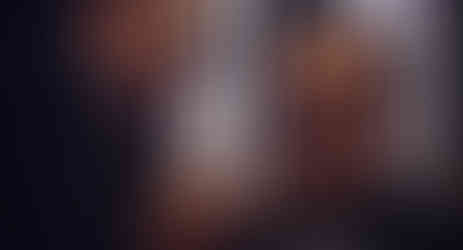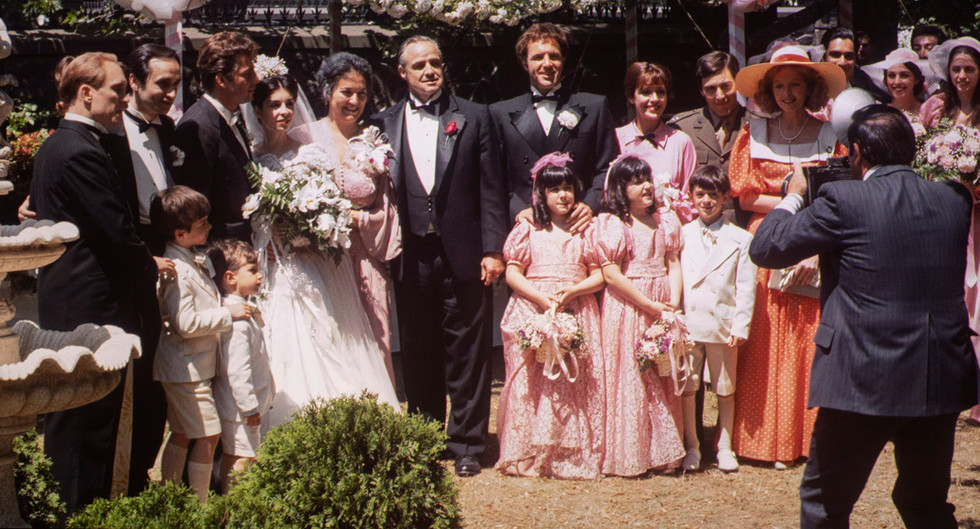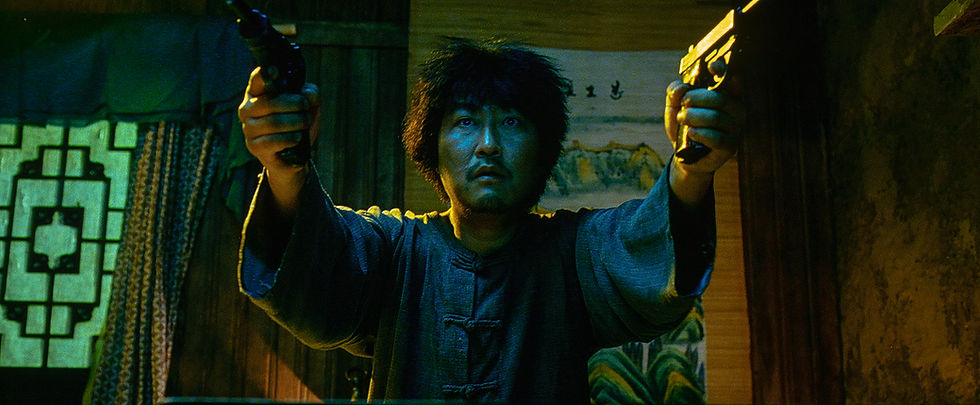Your invitation to the Corleone reunion – “The Godfather Trilogy”
- Bill Kelley III

- Mar 25, 2022
- 8 min read
Updated: Mar 27, 2022
4K ULTRA HD REVIEW / HDR FRAME SHOTS

Marlon Brando as the Godfather, Don Vito Corleone, and Al Pacino plays his son Michael.
(Click on an image to scroll through the larger versions)
“THE GODFATHER TRILOGY”
4K Ultra HD, Digital copy; 1972, 1974, 1990; R for violence, profanity, and brief nudity, streaming via Amazon Prime Video (4K), Apple TV (4K), Vudu (4K), YouTube (4K)
Best extra: Full Circle: Preserving “The Godfather” (disc only)
IT TOOK FIVE YEARS for Paramount Pictures, writer/director Francis Ford Coppola and his colleagues at American Zoetrope to create a new, grandioso 4K restoration of “The Godfather” Trilogy.
The first part of the crime opera opened a half-century ago in New York on March 24, 1972. “The Godfather” won three Oscars for Best Picture, Best Actor for Marlon Brando as Don Vito Corleone, and Best Screenplay based on Mario Puzo's book of the same name.
“The Godfather” and “Godfather: Part II” has been considered cinema masterpieces for decades, praised by critics and fans alike. “The Godfather” is positioned at No. 2 in the American Film Institute’s top 100 Greatest American films, right behind Orson Welles’ “Citizen Kane.” “The Godfather: Part II” was selected No. 32, sandwiched between film noir classic “The Maltese Falcon” (1941) and “One Flew Over the Cuckoo’s Nest” (1975).
(1&2) Dark moody lighting from cinematographer Gordon Willis as Italian immigrant Bonasera, an undertaker (Salvatore Corsitto), has come to ask for a favor. (3) The cat held by Brando was a stray director Francis Ford Coppola found on the Paramount backlot. The addition was improv, but the cat purred so much Brando’s dialogue had to be looped. (4) The lavish Sicilian wedding ceremony was held at the Corleone compound for Connie Corleone (Talia Shire, the sister of Francis Ford Coppola) and her groom Carlo Rizzi (Gianni Russo). An older gentleman hops onto the stage and sings the Italian song “Che la Luna.” (5) Michael Corleone talks to his girlfriend Kay Adams (Diane Keaton) during the wedding party. (6) The Corleone family portrait.
In his 1972 review, New York Times critic Vincent Canby wrote, “It’s one of the most brutal and moving chronicles of American life ever designed within the limits of popular entertainment.” Roger Ebert of the Chicago Sun-Times said, “The real world is replaced by an authoritarian patriarchy where power and justice flow from the Godfather, and the only villains are traitors.”
“The Godfather: Part II” won six Academy Awards including Best Picture, Best Supporting Actor for Robert De Niro as young Don Vito Corleone, Best Director, Best Screenplay, Art Direction, and Best Score. Many critics and fans consider the second installment the better film, as it moves forward and backward in time telling the saga of Don Vito and his son Michael played by Al Pacino.
“Godfather: Part III” received mixed reviews, even as it received seven Oscar nominations including Best Picture, Best Director, Best Supporting Actor for Andy Garcia as Vincent Mancini.
In 2007 Paramount and Zoetrope produced its first 4K restoration of the Trilogy, but advances in digital technology, including high dynamic range (HDR) and the discovery of additional original footage, clearly gives the 2022 edition an advantage over the previous work.
“We keep unearthing more and more material,” says Zoetrope film archivist James Mockoski during the featurette “Full Circle: Preserving ‘The Godfather.’” For years, ‘The Godfather’ had been a patchwork of various materials. Sections of the camera negative had gone missing or were too badly damaged for a remaster. Meanwhile, Paramount kept searching for the lost footage.
Andrea Kalas, Paramount Senior Vice President of Asset Management says, they involved cinematographer Gordon Willis and Coppola in 2007. “It was a major moment because it had not been restored before.”
(1) Hollywood producer Jack Woltz (John Marley) awakes to find himself and his bedsheets covered in blood. He then pulls the sheets back to find the head of his prized horse. (2) The violence escalates with the killing of Luca Brasi, who had been Don Corleone’s personal enforcer. (3&4) December 1945, Don Vito Corleone is gunned down in an assassination attempt after he refused to invest in Virgil Sollozzo’s heroin operation. (5) After the killing of Paulie Gatto (John Martino), actor Richard Castellano (Peter Clemenza) delivers the famous ad-libbed line, “leave the gun, take the cannoli.”
Warner Brothers’ post-production house, Motion Picture Imaging, handled the first restoration, using as much of the original negative as possible. Around 70 percent was still usable. Over the years, it had been “somewhat misused,” says Warner senior colorist Jan Yarbrough. Too many copies had been made off the negative, damaging sections were replaced by dupe negatives.
Restoration expert Robert Harris (“My Fair Lady,” “Lawrence of Arabia”) oversaw the project, becoming an adviser this go-around. Kalas considers the previous work “a wonderful blueprint, but we knew we had to take that restoration and make it even better.”
This time, restoration consultant Laura Thornburg oversaw the project, which began in 2016. Once the film was scanned in 4K, Zoetrope handled the digital clean-up in San Francisco – spending over 4,000 hours removing scratches, dirt, and giant stains. “That was really nice to have that sort of hands-on care,” Kalas says. “It just seemed right that we could lend a hand and Francis could be very involved in the collaboration,” Mockoski says.
Much of the restoration happened during COVID, as Paramount’s film librarian Jeffrey Osmer took dozens of boxes of the original film home to catalog what was available. Plus, they discovered all of the cutouts, trims, and dailies, while new original footage was uncovered, which had been labeled under wrong titles.
Coppola’s original handwritten line script was used, providing detailed descriptions of each shot, with the camera position and lens selection. The notes were invaluable to Osmer, as he continued to search for lost footage.
(1-3) The Louis Restaurant in The Bronx, New York, is the meeting spot for Michael Corleone, Virgil Sollozzo (Al Lettieri), and Capt. McCluskey (Sterling Hayden). Michael shots both men, which leads to the Five Families War. (4&5) Don Corleone finally returns home after the assassination attempt.
Coppola, at 82, admits it’s hard to believe that “The Godfather” was made fifty years ago. “I have a lot of sentiment about that film because it certainly changed my life,” he says during the five-minute introduction on the 4K disc.
He never imagined it would have “such an impact throughout the world.” His daughter Sofia Coppola – who also became a filmmaker (“Lost in Translation”) was born during the production. She makes her first screen appearance as Michael Corleone’s infant daughter at the end of “The Godfather.” She would also co-star in the third installment, as Michael’s teenage daughter. That decision has tainted the movie for years. Winona Ryder was supposed to play the part, but bailed just as the shooting began.
“All movies are an experience of collaboration. No one person makes them, and certainly, that is the case here. The director is a ringleader, and I am lucky to have had such a group of talent to work with.” — Francis Ford Coppola
Coppola finishes by saying, “I hope all of you enjoy this beautiful restoration, and the third segment, which is now much more the way Mario and I intended.” The re-edited “The Godfather: Part III” improves the pacing and features a new title: “The Godfather, Coda: The Death of Michael Corleone,” which was released separately last year, but only in 1080p.
EXTRAS
The five-disc set includes a bonus disc that houses hours of documentaries and featurettes. Several new featurettes “Full Circle: Preserving ‘The Godfather’” highlights the new restoration work; “Capturing The Corleones: Through the Lens of photographer Steve Schapiro,” the on-the-set photographer during the production; “The Godfather: Home Movies,” with behind-the-scene 8mm footage captured at the Staten Island estate that subbed for the Corleone compound, and “Restoration Comparisons” between the 2007 work to the new restoration.
The best archive documentary, “The Masterpiece That Almost Wasn’t,” has interviews with Coppola, filmmaker George Lucas, and American Zoetrope co-founder Walter Murch recalling the difficulty young filmmakers faced breaking into Hollywood in the late 1960s and early ‘70s. They started Zoetrope in San Francisco to produce their own films. At the same time, Paramount had fallen to the bottom of the Hollywood ladder and was sold for a mere $600,000 to Gulf & Western, an investment company. Studio executive Robert Evans bought the rights for “Love Story” giving Paramount the blockbuster they needed, which led the way to getting the rights for “The Godfather.”
(1&2) Michael heads to Sicily to lie low for two years. Two bodyguards protect him and he meets a beautiful young woman Apollonia Vitelli (Simonetta Stefanelli). (3&4) Sonny Corleone (James Caan) the eldest son, is ambushed by Barzini hitmen. His father makes a positive ID of the body.
Another favorite, the 113-minute “The Godfather Family: A Look Inside,” gives a peek into the production of “The Godfather: Part III” as Coppola and the cast and crew recount their memories of making the first two films. A 4K disc features the original Theatrical Cut of "Part III" and the "Director's Cut" which runs an extra 10-minutes.
Plus, two interactive graphics: “The Corleone Family Tree” and “The Crime Organization Chart,” featuring bios for each character.
The trilogy also includes three commentaries by Coppola. In “The Godfather,” he jumps straight to the first scene, with a story on how a good friend “was disappointed” after reading the first five pages of an early draft. They suggested it needed a dramatic opener, similar to what Coppola had created for his Oscar-winning script for “Patton.”
Hence, a rewrite and the development of a scene “like the old Roman client system,” says the director. It’s the wedding day of Connie Corleone (Talia Shire), the daughter of the Godfather, Don Vito Corleone. An Italian immigrant Bonasera, an undertaker (Salvatore Corsitto), has come to ask for a favor. His daughter was badly beaten by her boyfriend and another young man, and he wants to avenge the assault. Corleone asks what he wants, and the undertaker whispers into his ear.
The scene is extraordinary, with strong overhead lighting causing deep, dark shadows around the eyes of each character, soulless men in a world of violence and kinship.
Coppola also tells how they used an early computer to control the zoom lens for the shot, as its pulls back so very slowly over three minutes “almost imperceptibly” from a tight shot of the undertaker to the wide shot over the Don’s shoulder.
It’s revealed how the severed horse head discovered in the Hollywood producer’s bed was REAL. It came from a dog food factory. James Caan, who played Sonny Corleone, had 147 blood “squibs” attached to him for the scene where he was ambushed.
During the commentary for “Part II,” Coppola confesses he never intended to make a second film, but Paramount pushed for a sequel. The head of the studio, Charlie Bluhdorn, kept telling him, “You’ve got the recipe for Coca-Cola and you don’t want to make any more bottles.” Coppola suggested Martin Scorsese as director, while he became producer, but Paramount gave a frantic NO!
VIDEO
All three films were scanned and mastered in 16-bit 4K from the original 35mm camera negative mostly (1.85:1 aspect ratio). “The Godfather” was the biggest challenge since so many moments were substituted with second-generation dub negatives, which increased film grain and reduced clarity. But, overall, this is an amazing restoration project, a more cohesive and balanced work from frame to frame and scene to scene.
Over 1,000 hours were spent with the HDR10 and Dolby Vision grading providing a substantial increase in overall contrast, with deeper blacks and controlled highlights, with more detail on both ends of the spectrum. The color palette has been toned to a slightly more neutral balance, while still exhibiting Willis’ intended warmth. The previous Blu-ray pushed the warmth too much. Film grain is evident from start to finish on all three films, and more pronounced where a second-generation negative was used. Meanwhile, clarity is several notches better than the 2007 restoration.
AUDIO
All three films feature a six-channel Dolby TrueHD soundtrack pushing the balanced sound effects from gun blasts to environmental sounds around the room. Also, a restored original mono 2.0 Dolby Digital soundtrack is available, with the music and dialogue front and center.
Golden subtitles, with a pleasing light typeface, are provided for the Italian language moments. They’re more engaging and easier to read than the subtitles on the digital platforms.
If there was ever a series of films to have in a 4K Ultra HD library – “The Godfather” Trilogy is the one you can’t refuse.
— Bill Kelley III, High-Def Watch producer






















































Thanks Bill, this motivates me to go for the new box set. I have the 2007 edition and as on the fence. I haven't gone full 4K yet, but this is one title that just might make me go there, an amazing review, thanks again!!